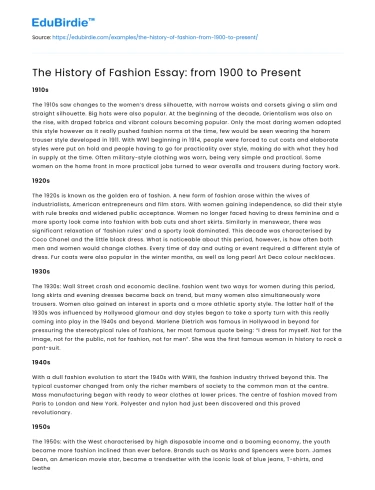1910s
The 1910s saw changes to the women’s dress silhouette, with narrow waists and corsets giving a slim and straight silhouette. Big hats were also popular. At the beginning of the decade, Orientalism was also on the rise, with draped fabrics and vibrant colours becoming popular. Only the most daring women adopted this style however as it really pushed fashion norms at the time, few would be seen wearing the harem trouser style developed in 1911. With WW1 beginning in 1914, people were forced to cut costs and elaborate styles were put on hold and people having to go for practicality over style, making do with what they had in supply at the time. Often military-style clothing was worn, being very simple and practical. Some women on the home front in more practical jobs turned to wear overalls and trousers during factory work.
1920s
The 1920s is known as the golden era of fashion. A new form of fashion arose within the wives of industrialists, American entrepreneurs and film stars. With women gaining independence, so did their style with rule breaks and widened public acceptance. Women no longer faced having to dress feminine and a more sporty look came into fashion with bob cuts and short skirts. Similarly in menswear, there was significant relaxation of ‘fashion rules’ and a sporty look dominated. This decade was characterised by Coco Chanel and the little black dress. What is noticeable about this period, however, is how often both men and women would change clothes. Every time of day and outing or event required a different style of dress. Fur coats were also popular in the winter months, as well as long pearl Art Deco colour necklaces.
Save your time!
We can take care of your essay
- Proper editing and formatting
- Free revision, title page, and bibliography
- Flexible prices and money-back guarantee
1930s
The 1930s: Wall Street crash and economic decline. fashion went two ways for women during this period, long skirts and evening dresses became back on trend, but many women also simultaneously wore trousers. Women also gained an interest in sports and a more athletic sporty style. The latter half of the 1930s was influenced by Hollywood glamour and day styles began to take a sporty turn with this really coming into play in the 1940s and beyond. Marlene Dietrich was famous in Hollywood in beyond for pressuring the stereotypical rules of fashions, her most famous quote being: “I dress for myself. Not for the image, not for the public, not for fashion, not for men”. She was the first famous woman in history to rock a pant-suit.
1940s
With a dull fashion evolution to start the 1940s with WWII, the fashion industry thrived beyond this. The typical customer changed from only the richer members of society to the common man at the centre. Mass manufacturing began with ready to wear clothes at lower prices. The centre of fashion moved from Paris to London and New York. Polyester and nylon had just been discovered and this proved revolutionary.
1950s
The 1950s: with the West characterised by high disposable income and a booming economy, the youth became more fashion inclined than ever before. Brands such as Marks and Spencers were born. James Dean, an American movie star, became a trendsetter with the iconic look of blue jeans, T-shirts, and leather jackets, something which then became highly popular for mass-market consumption. At the same time, Italian tailored suits came into the trend with single-breasted suits, tapered pants, narrow ties and pointed shoes.
1960s
Unisex clothing characterized the early 1960s. Cocktail dresses of the 1950s were also popular in the early 60s for dinner parties and evening wear. Mini skirts hit shops in 1965. Tight trousers and brightly coloured military jackets were popular within menswear. Yves Sait Laurent was popular among youths and jeans became more accepted as daily wear. The Mod fashion really took speed in the 60s around London and the rest of the world. For Women, this meant short shift dresses, bold colours and geometric shapes. Co-ord outfits also became popular with matching jackets to dresses or top and skirt sets.
1970s
Punks of the 1970s with ripped t-shirts, chains, and wild hairdos. Flared trousers, hippy maxi skirts, and bell-bottomed jeans. In the late 70s, cowl neck shirts, pantsuits and tracksuits became popular. Many believe the 70s to be one of the most stylish decades, with such a wide range of accepted styles and fashion movements, polyester was the material of choice and bright colours were highly desirable. High cut books and low cut flared jeans were all the rage of 1973. For men, half-buttoned-up stripy shirts with chest hair on the show were highly on-trend, along with sideburns and tennis headbands.
1980s
Jeans (in particular ripped knee jeans) were a wardrobe staple in the 1980s. Women often wore tailored suits with wide padded shoulders. Nike, Adidas and Reebok became highly popular fashionable sportswear, with tracksuits, leggings and trainers. With the sporty trends, leg warmers were often paired with neon leggings and infamous big permed hair, often the bigger the better. This look was also often fished with a sporty cut off jumper.
1990s
Fashion shows changed styles in the 1990s. Globalization leading to an international influence in fashion. With international styles coming in through television and media. Subcultures also developed with groups of like-minded people developing their own style; from hippies to rockers. Synthetic materials also became popular as well as luxury grads such as Prada and Gucci.
2000s
The 2000s were the basis for ‘streetwear style’ where comfort is key. 5 key countries drove fashion ideas and fashion innovation: America, Britain, France, Japan and Italy. This is when fast fashion was born, online selling platforms and mobile obsessed consumers.






 Stuck on your essay?
Stuck on your essay?

